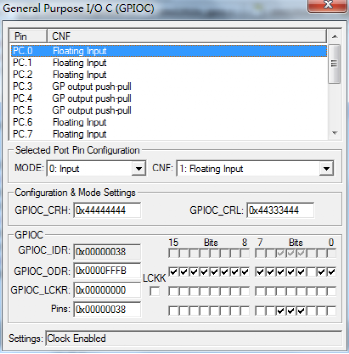標題: STM32F10X通用IO口的操作 [打印本頁]
作者: liuyy 時間: 2015-1-12 16:48
標題: STM32F10X通用IO口的操作
與GPIO相關的寄存器
STM32F10x處理器公有7個IO端口:A、B、C、D、E、F、G,每個端口上有16個引腳。
每個IO端口都有2個32位的配置寄存器,2個32位的數據寄存器(input output),一個32位的置位/復位寄存器,一個16位的復位寄存器,一個32位的鎖定寄存器。
具體有:
端口配置寄存器低位 GPIO_CRL
端口配置寄存器高位 GPIO_CRH
端口輸入數據寄存器 GPIO_IDR
端口輸出數據寄存器 GPIO_ODR
端口位置位/復位寄存器 GPIO_BSRR
端口位復位寄存器 GPIO_BRR
端口配置鎖定寄存器 GPIO_LCKR
事件控制寄存器 EVCR
復用重映射和調試I/O配置寄存器 MAPR
外部中斷線路0-15配置寄存器 EXTICR
這些寄存器在系統頭文件stm32f10x.h的定義如下:
typedef struct
{
__IO uint32_t CRL;
__IO uint32_t CRH;
__IO uint32_t IDR;
__IO uint32_t ODR;
__IO uint32_t BSRR;
__IO uint32_t BRR;
__IO uint32_t LCKR;
} GPIO_TypeDef;
/**
* @brief Alternate Function I/O
*/
typedef struct
{
__IO uint32_t EVCR;
__IO uint32_t MAPR;
__IO uint32_t EXTICR[4];
uint32_t RESERVED0;
__IO uint32_t MAPR2;
} AFIO_TypeDef;
/**
端口引腳的設置
l引腳原理圖
l可以設置的狀態
l不同狀態相關寄存器的設置值
l程序設計時不同狀態引用的宏定義
函數
與GPIO相關的函數:在stm32f10x_gpio.h中進行了聲明
1.void GPIO_DeInit(GPIO_TypeDef* GPIOx);//IO缺省值初始化函數
2.void GPIO_AFIODeInit(void);//初始化復用功能寄存器為初始化值
3.void GPIO_Init(GPIO_TypeDef* GPIOx, GPIO_InitTypeDef* GPIO_InitStruct);//使用GPIO_InitStruct中的參數對IO口進行初始化
4.void GPIO_StructInit(GPIO_InitTypeDef* GPIO_InitStruct);把GPIO_InitStruct中的每個參數按缺省值填入
5.uint8_t GPIO_ReadInputDataBit(GPIO_TypeDef* GPIOx, uint16_t GPIO_Pin);讀取指定端口引腳的輸入
6.uint16_t GPIO_ReadInputData(GPIO_TypeDef* GPIOx);讀取指定端口的輸入
7.uint8_t GPIO_ReadOutputDataBit(GPIO_TypeDef* GPIOx, uint16_t GPIO_Pin);讀取指定端口引腳的輸出
8.uint16_t GPIO_ReadOutputData(GPIO_TypeDef* GPIOx);讀取指定端口的輸出
9.void GPIO_SetBits(GPIO_TypeDef* GPIOx, uint16_t GPIO_Pin);設置指定端口引腳的位
10.void GPIO_ResetBits(GPIO_TypeDef* GPIOx, uint16_t GPIO_Pin);清除指定端口引腳的位
11.void GPIO_WriteBit(GPIO_TypeDef* GPIOx, uint16_t GPIO_Pin, BitAction BitVal);設置或清除指定的數據端口為
12.void GPIO_Write(GPIO_TypeDef* GPIOx, uint16_t PortVal);向指定的端口寫入數據
13.void GPIO_PinLockConfig(GPIO_TypeDef* GPIOx, uint16_t GPIO_Pin);鎖定端口引腳的設置寄存器
14.void GPIO_EventOutputConfig(uint8_t GPIO_PortSource, uint8_t GPIO_PinSource);//選擇端口引腳作為事件輸出
15.void GPIO_EventOutputCmd(FunctionalState NewState);使能 或失能事件輸出
16.void GPIO_PinRemapConfig(uint32_t GPIO_Remap, FunctionalState NewState);改變指定管腳的地址映射
17.void GPIO_EXTILineConfig(uint8_t GPIO_PortSource, uint8_t GPIO_PinSource);選擇端口引腳用作外部中斷線路
18.void GPIO_ETH_MediaInterfaceConfig(uint32_t GPIO_ETH_MediaInterface);選擇以太網的接口
外設初始化和設置操作過程
1、在主應用文件中,聲明一個PPP_InitTypeDef結構體類型 ,如PPP_InitTypeDef PPP_InitStructure;
這個PPP_InitTypeDef結構體已經在PPP對應的頭文件中進行了定義。
可以看到這個結構體中有3個元素。管腳、端口速度、端口模式
2、為變量PPP_InitStructure的各個結構成員填入允許的值。
采用兩種方式:
PPP_InitStructure.member1=val1;
PPP_InitStructure.member2=val2;
PPP_InitStructure.memberN=valN;
以上步驟可以合并在同一行里,用于優化代碼大小:
PPP_InitTypeDef PPP_InitStructure={val1,val2,……valN}
僅設置結構體中的部分成員:這種情況下,用戶應當首先調用函數PPP_SturcInit( )來初始化變量PPP_InitStructure,然后再修改其中需要修改的成員。這樣可以保證其他成員(多為缺省值)被正確填入。
PPP_StructInit (&PPP_InitStructure);
PPP_InitStructure.memberX=valX;
PPP_InitStructure.memberY=valY;
3、調用函數PPP_Init( )來初始化外設PPP。
4、在這一步,外設PPP已被初始化。可以調用函數PPP_Cmd( )來使能之。
PPP_Cmd(PPP,ENABLE);
注意:
1、在設置一個外設之前,必須調用以下一個函數來使能它的時鐘:
RCC_AHBPeriphClockCmd(RCC_AHBPeriph_PPPx,ENABLE);
RCC_APB2PeriphClockCmd(RCC_APB2Periph_PPPx,ENABLE);
RCC_APB1PeriphClockCmd(RCC_APB1Periph_PPPx,ENABLE);
具體應該調用那個函數看下圖
2、可以調用函數PPP_DeInit(PPP)來把外設PPP的所用寄存器復位為缺省值
3、在外設設置完成后,繼續修改它的一些參數,可以參照如下步驟:
PPP_InitStructure.memberX=valx;
PPP_InitStructure.memberY=valy;
PPP_Init(PPP,&PPP_InitStructure);
總結
如何將GPIOA設置成浮動輸入模式
下面看一個實際的例子。
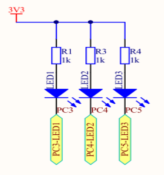
循環點亮如圖的三個發光二極管。
在模板的文件中新建一個文件夾led.
在MDK中新建led.h和led.c文件
Led.c文件內容如下:
#include"led.h"
/*
函數名:LED_GPIO_Config
描述: 配置LED用到的I/O口
輸入 : 無
輸出: 無
*/
void LED_GPIO_Config(void)
{
GPIO_InitTypeDef GPIO_InitStructure;//定義一個GPIO_InitTypeDef類型的結構體
GPIO_InitStructure.GPIO_Pin=GPIO_Pin_3|GPIO_Pin_4|GPIO_Pin_5; //選擇要控制的引腳
GPIO_InitStructure.GPIO_Mode=GPIO_Mode_Out_PP;//設置引腳模式為通用推挽輸出
GPIO_InitStructure.GPIO_Speed=GPIO_Speed_50MHz;//設置引腳速率為50MHz
GPIO_Init(GPIOC,&GPIO_InitStructure);//調用庫函數初始化GPIOC
RCC_APB2PeriphClockCmd( RCC_APB2Periph_GPIOC, ENABLE); //開啟GPIOC的外設時鐘
GPIO_SetBits(GPIOC,GPIO_Pin_3|GPIO_Pin_4|GPIO_Pin_5);//關閉所有的led
}
Led.h文件如下:
#ifndef __LED_H
#define __LED_H
#include"stm32f10x.h"
#define ON 0
#define OFF 1
#define LED1(a) if(a) GPIO_SetBits(GPIOC,GPIO_Pin_3);\
else GPIO_ResetBits(GPIOC,GPIO_Pin_3)//調用置位和復位函數函數
#define LED2(a) if(a)GPIO_SetBits(GPIOC,GPIO_Pin_4);\
else GPIO_ResetBits(GPIOC,GPIO_Pin_4)
#define LED3(a) if(a) GPIO_SetBits(GPIOC,GPIO_Pin_5);\
else GPIO_ResetBits(GPIOC,GPIO_Pin_5)
/*也可以調用void GPIO_Write(GPIO_TypeDef* GPIOx, uint16_t PortVal);向指定的端口寫入數據
#define LED1(a) if(a) GPIO_Write(GPIOC,0xfffb );\
else GPIO_Write(GPIOC,0xffff )
#define LED2(a) if(a) GPIO_Write(GPIOC,0xfff7 );\
else GPIO_Write(GPIOC,0xffff )
#define LED3(a) if(a) GPIO_Write(GPIOC,0xffef );\
else GPIO_Write(GPIOC,0xffff )
*/
void LED_GPIO_Config(void);
#endif
在main.c文件中輸入如下代碼:
#include "stm32f10x.h"
#include "led.h"
void Delay(vu32 nCount);
int main(void)
{
LED_GPIO_Config();//
while(1)
{
LED1(ON);
Delay(0x0fffef);
LED1(OFF);
LED2(ON);
Delay(0x0fffef);
LED2(OFF);
LED3(ON);
Delay(0x0fffef);
LED3(OFF);
}
}
void Delay(vu32 nCount)
{
for(;nCount!=0;nCount--);
}
打開stm32f10x_conf.h文件,將不需要的頭文件注釋掉
/* Includes ------------------------------------------------------------------*/
/* Uncomment/Comment the line below to enable/disable peripheral header file inclusion */
//#include "stm32f10x_adc.h"
//#include "stm32f10x_bkp.h"
//#include "stm32f10x_can.h"
//#include "stm32f10x_cec.h"
//#include "stm32f10x_crc.h"
//#include "stm32f10x_dac.h"
//#include "stm32f10x_dbgmcu.h"
//#include "stm32f10x_dma.h"
//#include "stm32f10x_exti.h"
//#include "stm32f10x_flash.h"
//#include "stm32f10x_fsmc.h"
#include "stm32f10x_gpio.h"
//#include "stm32f10x_i2c.h"
///#include "stm32f10x_iwdg.h"
//#include "stm32f10x_pwr.h"
#include "stm32f10x_rcc.h"
//#include "stm32f10x_rtc.h"
//#include "stm32f10x_sdio.h"
//#include "stm32f10x_spi.h"
//#include "stm32f10x_tim.h"
//#include "stm32f10x_usart.h"
//#include "stm32f10x_wwdg.h"
//#include "misc.h" /* High level functions for NVIC and SysTick (add-on to CMSIS functions) */
“編譯”----“debug”
運行結果如下圖
具體的代碼分析如下:
在led.c文件中定義了一個函數, void LED_GPIO_Config(void).作用是對端口進行初始化。
初始化設置的步驟,就像前面說明的那樣。
1、GPIO_InitTypeDef GPIO_InitStructure;//定義一個GPIO_InitTypeDef類型的結構體
對于GPIO_InitTypeDef這個結構體在stm32f10x_gpio.h頭文件中做了如下定義
typedef struct
{
uint16_t GPIO_Pin; /*!< Specifies the GPIO pins to be configured.
This parameter can be any value of @ref GPIO_pins_define */
GPIOSpeed_TypeDef GPIO_Speed; /*!< Specifies the speed for the selected pins.
This parameter can be a value of @ref GPIOSpeed_TypeDef */
GPIOMode_TypeDef GPIO_Mode; /*!< Specifies the operating mode for the selected pins.
This parameter can be a value of @ref GPIOMode_TypeDef */
}GPIO_InitTypeDef;
包含3個不同類型的成員,引腳、速度、模式。
2、然后是對這3個成員賦值
GPIO_InitStructure.GPIO_Pin=GPIO_Pin_3|GPIO_Pin_4|GPIO_Pin_5; //選擇要控制的引腳
GPIO_InitStructure.GPIO_Mode=GPIO_Mode_Out_PP;//設置引腳模式為通用推挽輸出
GPIO_InitStructure.GPIO_Speed=GPIO_Speed_50MHz;//設置引腳速率為50MHz
其中引腳的選項在stm32f10x_gpio.h中是如下定義的,
/** @defgroup GPIO_pins_define
* @{
*/
#define GPIO_Pin_0 ((uint16_t)0x0001) /*!< Pin 0 selected */
#define GPIO_Pin_1 ((uint16_t)0x0002) /*!< Pin 1 selected */
#define GPIO_Pin_2 ((uint16_t)0x0004) /*!< Pin 2 selected */
#define GPIO_Pin_3 ((uint16_t)0x0008) /*!< Pin 3 selected */
#define GPIO_Pin_4 ((uint16_t)0x0010) /*!< Pin 4 selected */
#define GPIO_Pin_5 ((uint16_t)0x0020) /*!< Pin 5 selected */
#define GPIO_Pin_6 ((uint16_t)0x0040) /*!< Pin 6 selected */
#define GPIO_Pin_7 ((uint16_t)0x0080) /*!< Pin 7 selected */
#define GPIO_Pin_8 ((uint16_t)0x0100) /*!< Pin 8 selected */
#define GPIO_Pin_9 ((uint16_t)0x0200) /*!< Pin 9 selected */
#define GPIO_Pin_10 ((uint16_t)0x0400) /*!< Pin 10 selected */
#define GPIO_Pin_11 ((uint16_t)0x0800) /*!< Pin 11 selected */
#define GPIO_Pin_12 ((uint16_t)0x1000) /*!< Pin 12 selected */
#define GPIO_Pin_13 ((uint16_t)0x2000) /*!< Pin 13 selected */
#define GPIO_Pin_14 ((uint16_t)0x4000) /*!< Pin 14 selected */
#define GPIO_Pin_15 ((uint16_t)0x8000) /*!< Pin 15 selected */
#define GPIO_Pin_All ((uint16_t)0xFFFF) /*!< All pins selected */
模式在stm32f10x_gpio.h頭文件中是如下定義的,
/**
* @brief Configuration Mode enumeration
*/
typedef enum //枚舉
{ GPIO_Mode_AIN = 0x0,
GPIO_Mode_IN_FLOATING = 0x04,
GPIO_Mode_IPD = 0x28,
GPIO_Mode_IPU = 0x48,
GPIO_Mode_Out_OD = 0x14,
GPIO_Mode_Out_PP = 0x10,
GPIO_Mode_AF_OD = 0x1C,
GPIO_Mode_AF_PP = 0x18
}GPIOMode_TypeDef;
速度在stm32f10x_gpio.h頭文件中是如下定義的,
/**
* @brief Output Maximum frequency selection
*/
typedef enum
{
GPIO_Speed_10MHz = 1,
GPIO_Speed_2MHz,
GPIO_Speed_50MHz
}GPIOSpeed_TypeDef;
3、GPIO_Init(GPIOC,&GPIO_InitStructure);//調用庫函數初始化GPIOC
這個函數在stm32f10x_gpio.c文件中是如下定義的,
/**
* @brief Initializes the GPIOx peripheral according to the specified
* parameters in the GPIO_InitStruct.
* @param GPIOx: where x can be (A..G) to select the GPIO peripheral.
* @param GPIO_InitStruct: pointer to a GPIO_InitTypeDef structure that
* contains the configuration information for the specified GPIO peripheral.
* @retval None
*/
void GPIO_Init(GPIO_TypeDef* GPIOx, GPIO_InitTypeDef* GPIO_InitStruct)
{
uint32_t currentmode = 0x00, currentpin = 0x00, pinpos = 0x00, pos = 0x00;
uint32_t tmpreg = 0x00, pinmask = 0x00;
/* Check the parameters */
assert_param(IS_GPIO_ALL_PERIPH(GPIOx));
assert_param(IS_GPIO_MODE(GPIO_InitStruct->GPIO_Mode));
assert_param(IS_GPIO_PIN(GPIO_InitStruct->GPIO_Pin));
/*---------------------------- GPIO Mode Configuration -----------------------*/
currentmode = ((uint32_t)GPIO_InitStruct->GPIO_Mode) & ((uint32_t)0x0F);//只取低4位
if ((((uint32_t)GPIO_InitStruct->GPIO_Mode) & ((uint32_t)0x10)) != 0x00)//為輸出模式
{
/* Check the parameters */
assert_param(IS_GPIO_SPEED(GPIO_InitStruct->GPIO_Speed));//檢查輸出的參數是否正確
/* Output mode */
currentmode |= (uint32_t)GPIO_InitStruct->GPIO_Speed;
}
/*---------------------------- GPIO CRL Configuration ------------------------*/
/* Configure the eight low port pins */
if (((uint32_t)GPIO_InitStruct->GPIO_Pin & ((uint32_t)0x00FF)) != 0x00)//如果是輸入模式
{
tmpreg = GPIOx->CRL;
for (pinpos = 0x00; pinpos < 0x08; pinpos++)
{
pos = ((uint32_t)0x01) << pinpos;
/* Get the port pins position */
currentpin = (GPIO_InitStruct->GPIO_Pin) & pos;
if (currentpin == pos)
{
pos = pinpos << 2;
/* Clear the corresponding low control register bits */
pinmask = ((uint32_t)0x0F) << pos;
tmpreg &= ~pinmask;
/* Write the mode configuration in the corresponding bits */
tmpreg |= (currentmode << pos);
/* Reset the corresponding ODR bit */
if (GPIO_InitStruct->GPIO_Mode == GPIO_Mode_IPD)
{
GPIOx->BRR = (((uint32_t)0x01) << pinpos);
}
else
{
/* Set the corresponding ODR bit */
if (GPIO_InitStruct->GPIO_Mode == GPIO_Mode_IPU)
{
GPIOx->BSRR = (((uint32_t)0x01) << pinpos);
}
}
}
}
GPIOx->CRL = tmpreg;
}
/*---------------------------- GPIO CRH Configuration ------------------------*/
/* Configure the eight high port pins */
if (GPIO_InitStruct->GPIO_Pin > 0x00FF)
{
tmpreg = GPIOx->CRH;
for (pinpos = 0x00; pinpos < 0x08; pinpos++)
{
pos = (((uint32_t)0x01) << (pinpos + 0x08));
/* Get the port pins position */
currentpin = ((GPIO_InitStruct->GPIO_Pin) & pos);
if (currentpin == pos)
{
pos = pinpos << 2;
/* Clear the corresponding high control register bits */
pinmask = ((uint32_t)0x0F) << pos;
tmpreg &= ~pinmask;
/* Write the mode configuration in the corresponding bits */
tmpreg |= (currentmode << pos);
/* Reset the corresponding ODR bit */
if (GPIO_InitStruct->GPIO_Mode == GPIO_Mode_IPD)
{
GPIOx->BRR = (((uint32_t)0x01) << (pinpos + 0x08));
}
/* Set the corresponding ODR bit */
if (GPIO_InitStruct->GPIO_Mode == GPIO_Mode_IPU)
{
GPIOx->BSRR = (((uint32_t)0x01) << (pinpos + 0x08));
}
}
}
GPIOx->CRH = tmpreg;
}
}
GPIO_Init(GPIOC,&GPIO_InitStructure);//調用庫函數初始化GPIOC函數中的
GPIO_InitStructure是我們自己定義的一個結構體變量名
GPIO_InitTypeDef GPIO_InitStructure;//定義一個GPIO_InitTypeDef類型的結構體變量
后記:
熟悉了GPIO的應用,對如何查找固件庫和參考手冊中的相關內容、系統頭文件及外設的.H和.C文件構成、函數的功能及調用,就有了一定的了解。舉一反三對于其他的外設基本數據的架構及應用與GPIO類似。至于.S的啟動文件的分析以后再做說明。
| 歡迎光臨 (http://m.zg4o1577.cn/bbs/) |
Powered by Discuz! X3.1 |
主站蜘蛛池模板:
日韩成人一区
|
午夜在线
|
精品国产99久久久久久宅男i
|
成人午夜在线观看
|
伊人影院综合
|
色爽|
久草福利在线观看
|
亚洲免费福利视频
|
精品久久一区二区
|
欧美日韩亚洲一区二区三区
|
久久精品av
|
欧美激情网址
|
538在线视频
|
国产亚洲视频在线观看
|
亚洲天天操
|
久久九九国产
|
精品视频久久
|
91色国产|
免费高清av|
国产逼逼
|
国产一区在线播放
|
糖心vlog精品一区二区
|
欧美精品一二三
|
午夜福利毛片
|
91污视频在线观看
|
日本丰满少妇做爰爽爽
|
成人做爰9片免费视频
|
成人片在线看
|
日韩一区不卡
|
国产农村妇女aaaaa视频
|
国产一区二区在线观看视频
|
免费网站观看www在线观看
|
日韩精品久久久久
|
国产永久免费视频
|
国产精品手机在线观看
|
久草综合在线
|
久久一区
|
在线少妇
|
国产精品视频免费在线观看
|
久久久久久久久久国产精品
|
高清一区二区
|
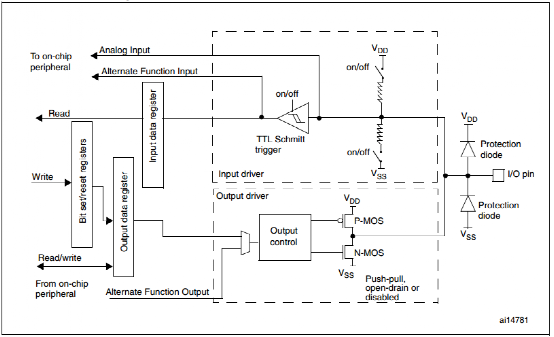

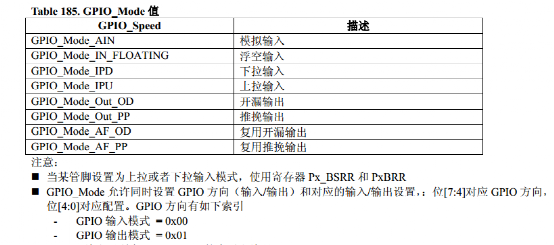
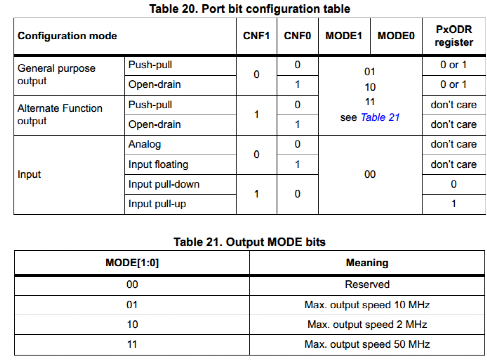
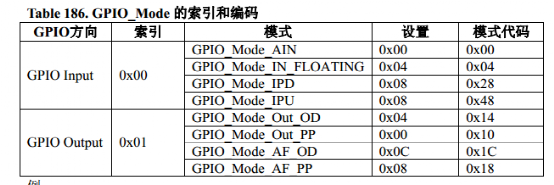
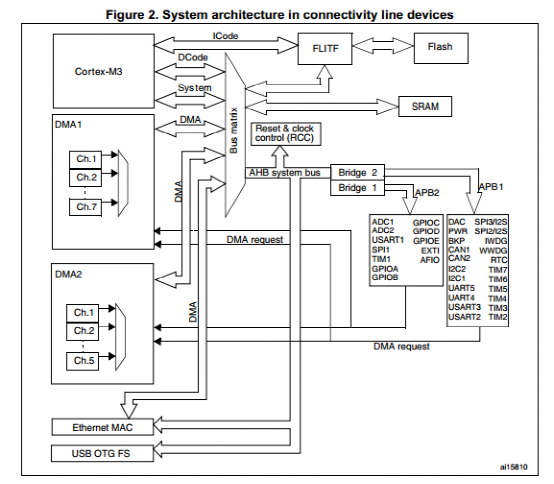

 循環點亮如圖的三個發光二極管。
循環點亮如圖的三個發光二極管。